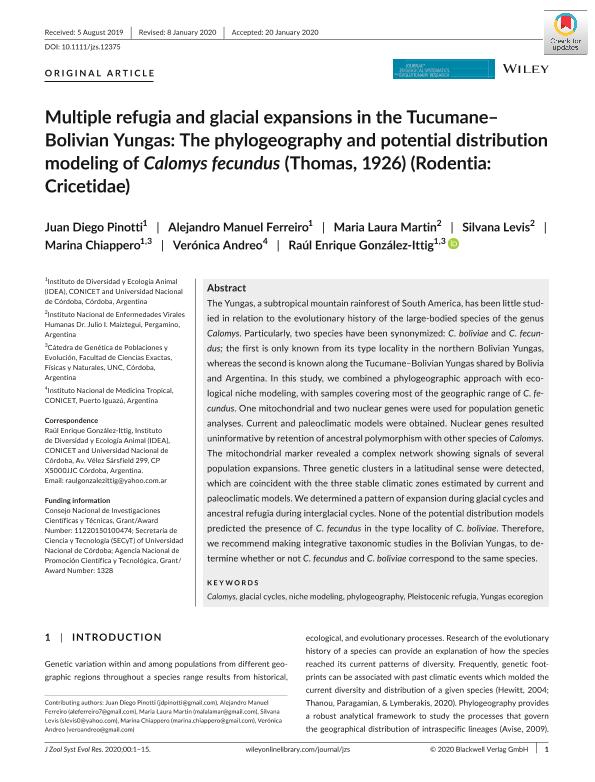Mostrar el registro sencillo del ítem
dc.contributor.author
Pinotti, Juan Diego

dc.contributor.author
Ferreiro, Alejandro Manuel

dc.contributor.author
Martin, Maria Laura

dc.contributor.author
Levis, Silvana del Carmen

dc.contributor.author
Chiappero, Marina Beatriz

dc.contributor.author
Andreo, Verónica Carolina

dc.contributor.author
González Ittig, Raúl Enrique

dc.date.available
2021-05-14T06:01:05Z
dc.date.issued
2020-11
dc.identifier.citation
Pinotti, Juan Diego; Ferreiro, Alejandro Manuel; Martin, Maria Laura; Levis, Silvana del Carmen; Chiappero, Marina Beatriz; et al.; Multiple refugia and glacial expansions in the Tucumane–Bolivian Yungas: The phylogeography and potential distribution modeling of Calomys fecundus (Thomas, 1926) (Rodentia: Cricetidae); Wiley Blackwell Publishing, Inc; Journal of Zoological Systematics and Evolutionary Research; 58; 4; 11-2020; 1359-1373
dc.identifier.issn
0947-5745
dc.identifier.uri
http://hdl.handle.net/11336/132046
dc.description.abstract
The Yungas, a subtropical mountain rainforest of South America, has been little studied in relation to the evolutionary history of the large-bodied species of the genus Calomys. Particularly, two species have been synonymized: C. boliviae and C. fecundus; the first is only known from its type locality in the northern Bolivian Yungas, whereas the second is known along the Tucumane–Bolivian Yungas shared by Bolivia and Argentina. In this study, we combined a phylogeographic approach with ecological niche modeling, with samples covering most of the geographic range of C. fecundus. One mitochondrial and two nuclear genes were used for population genetic analyses. Current and paleoclimatic models were obtained. Nuclear genes resulted uninformative by retention of ancestral polymorphism with other species of Calomys. The mitochondrial marker revealed a complex network showing signals of several population expansions. Three genetic clusters in a latitudinal sense were detected, which are coincident with the three stable climatic zones estimated by current and paleoclimatic models. We determined a pattern of expansion during glacial cycles and ancestral refugia during interglacial cycles. None of the potential distribution models predicted the presence of C. fecundus in the type locality of C. boliviae. Therefore, we recommend making integrative taxonomic studies in the Bolivian Yungas, to determine whether or not C. fecundus and C. boliviae correspond to the same species.
dc.format
application/pdf
dc.language.iso
eng
dc.publisher
Wiley Blackwell Publishing, Inc

dc.rights
info:eu-repo/semantics/openAccess
dc.rights.uri
https://creativecommons.org/licenses/by-nc-sa/2.5/ar/
dc.subject
CALOMYS
dc.subject
GLACIAL CYCLES
dc.subject
NICHE MODELING
dc.subject
PHYLOGEOGRAPHY
dc.subject
PLEISTOCENIC REFUGIA
dc.subject
YUNGAS ECOREGION
dc.subject.classification
Ecología

dc.subject.classification
Ciencias Biológicas

dc.subject.classification
CIENCIAS NATURALES Y EXACTAS

dc.subject.classification
Genética y Herencia

dc.subject.classification
Ciencias Biológicas

dc.subject.classification
CIENCIAS NATURALES Y EXACTAS

dc.title
Multiple refugia and glacial expansions in the Tucumane–Bolivian Yungas: The phylogeography and potential distribution modeling of Calomys fecundus (Thomas, 1926) (Rodentia: Cricetidae)
dc.type
info:eu-repo/semantics/article
dc.type
info:ar-repo/semantics/artículo
dc.type
info:eu-repo/semantics/publishedVersion
dc.date.updated
2021-05-11T18:12:49Z
dc.journal.volume
58
dc.journal.number
4
dc.journal.pagination
1359-1373
dc.journal.pais
Reino Unido

dc.journal.ciudad
Londres
dc.description.fil
Fil: Pinotti, Juan Diego. Consejo Nacional de Investigaciones Científicas y Técnicas. Centro Científico Tecnológico Conicet - Córdoba. Instituto de Diversidad y Ecología Animal. Universidad Nacional de Córdoba. Facultad de Ciencias Exactas Físicas y Naturales. Instituto de Diversidad y Ecología Animal; Argentina
dc.description.fil
Fil: Ferreiro, Alejandro Manuel. Consejo Nacional de Investigaciones Científicas y Técnicas. Centro Científico Tecnológico Conicet - Córdoba. Instituto de Diversidad y Ecología Animal. Universidad Nacional de Córdoba. Facultad de Ciencias Exactas Físicas y Naturales. Instituto de Diversidad y Ecología Animal; Argentina
dc.description.fil
Fil: Martin, Maria Laura. Instituto Nacional de Enfermedades Virales Humanas Dr. Julio I. Maiztegui; Argentina
dc.description.fil
Fil: Levis, Silvana del Carmen. Instituto Nacional de Enfermedades Virales Humanas Dr. Julio I. Maiztegui; Argentina
dc.description.fil
Fil: Chiappero, Marina Beatriz. Consejo Nacional de Investigaciones Científicas y Técnicas. Centro Científico Tecnológico Conicet - Córdoba. Instituto de Diversidad y Ecología Animal. Universidad Nacional de Córdoba. Facultad de Ciencias Exactas Físicas y Naturales. Instituto de Diversidad y Ecología Animal; Argentina. Universidad Nacional de Córdoba. Facultad de Cs.exactas Físicas y Naturales. Cátedra de Genética de Poblaciones y Evolución; Argentina
dc.description.fil
Fil: Andreo, Verónica Carolina. Instituto Nacional de Medicina Tropical; Argentina. Consejo Nacional de Investigaciones Científicas y Técnicas; Argentina
dc.description.fil
Fil: González Ittig, Raúl Enrique. Consejo Nacional de Investigaciones Científicas y Técnicas. Centro Científico Tecnológico Conicet - Córdoba. Instituto de Diversidad y Ecología Animal. Universidad Nacional de Córdoba. Facultad de Ciencias Exactas Físicas y Naturales. Instituto de Diversidad y Ecología Animal; Argentina. Universidad Nacional de Córdoba. Facultad de Cs.exactas Físicas y Naturales. Cátedra de Genética de Poblaciones y Evolución; Argentina
dc.journal.title
Journal of Zoological Systematics and Evolutionary Research

dc.relation.alternativeid
info:eu-repo/semantics/altIdentifier/doi/http://dx.doi.org/10.1111/jzs.12375
dc.relation.alternativeid
info:eu-repo/semantics/altIdentifier/url/https://onlinelibrary.wiley.com/doi/10.1111/jzs.12375
Archivos asociados
